Give it a listen (and subscribe while you're at it):
If I had to sum up what we are going for in one sentence, it would be this: Both you and every one of the human opponents you will face in a day have a limited reservoir of mental energy; the capacity to make good decisions; what in other contexts has been called willpower. Most of the edges you can sharpen in paper Magic versus Online or Arena have to do with finding shortcuts to conserve yours or force your opponents to use an inordinate amount of theirs.
For the last little bit, almost everything, written by me and almost everyone else, almost by necessity, has been Arena-centric.
But with MTGVegas under the community's collective belts - with, come on, six-time Pro Tour Top 8 competitor Shuhei Nakamura and two-time World Champion Shahar Shenhar playing in the elimination rounds - it seems like the hunger for big, long, paper tournaments is there-slash-back.
Are we all going to be chasing whatever the equivalent of Grand Prix glory is? Traveling long distances to lean into "the Gathering" half of Magic? If, like me, you missed Vegas... Can't imagine you don't find yourself with a little bit of that old itch.
While it's still half a year away, I just found out about this:
Relatedly, I think I am probably going to this. pic.twitter.com/TYMmRadhbv
— Brian Kowal (@bkowal23) November 25, 2021
Prior to last week I had no idea what a Premodern was. But you can bet your last Green mana by spring of next year I'll have internalized its ins and outs. Why? Because I just want to be part of the Gathering! If you feel the same way - even if you never played long physical tournaments prior to the Pandemic - hopefully you can get a little value (and more than a little Expected Value) out of this article.
Assuming you're used to Arena (or still slog it through MTGO), let me tell you: The skills you exercise in paper are different; or perhaps more accurately, there are simply more of them. For instance, Arena does a lot of bookkeeping for you. Not only will it keep visible cards in hand that the opponent has already shown you, it will remember the bottom of your library if you scry; and for that matter, how many cards are in either library.
I'm not going to address apps that tell you how likely you are to draw a particular card (or maybe more saliently, land); because those aren't actually a native feature of Arena. I personally don't use them, but realize that kinda sorta puts me at a net disadvantage. Just keep in mind that if you're relying on an app to do your probability for you, there is going to be a hole in your game once you transition [back] to long paper tournaments.
If I had to sum up what we are going for in one sentence, it would be this: Both you and every one of the human opponents you will face in a day have a limited reservoir of mental energy; the capacity to make good decisions; what in other contexts has been called willpower. Most of the edges you can sharpen in paper Magic versus Online or Arena have to do with finding shortcuts to conserve yours or force your opponents to use an inordinate amount of theirs.
Stage Zero: Standard Operating Procedure
Remember when Autumn Burchett mismatched all their Islands on the way to winning however many consecutive Tempo tournaments?
I even aped them myself a couple of times in Modern:
Mismatching lands to this extent is a hard troll in competitive Constructed. There is only one goal to a deliberate mismatch, and that is to get a reaction. The baseline assumption is to use all the same art for every basic; and probably for every card in your deck, where possible. Have you ever thought about why?
The theory is that if your opponent hits you with a Duress or a Peek and sees an Island with particular art, and then you draw and play another one [with different art] they get free information about your hand. By playing the new Island, you tell them you still have that original Island. By the way: The fact that Arena puts a little eyeball emoji on the original Island doesn't stop streamers from making the exact same error online, every day.
You can avoid all that by simply playing all the same art. It doesn't matter how many Islands you draw from that point, or how careless you are about playing which ones in what order: Your opponent never gains incremental information.
Yes - there are ways around this. For instance, some players turn "revealed" cards upside-down in their hands... This is kind of the equivalent of Arena bookkeeping. It theoretically saves you from making certain types of small misplays, but does ask you to use some of your own precious mental energy... In favor of your opponent. Plus, paper Magic isn't Arena: Especially in long tournaments you don't need to be giving the enemy free expectation percentage, or doing them any mental energy bookkeeping favors.
When I did it with the above Modern Red Deck, I was for certain deliberately trolling my opponents. In reality, it ended up quite disappointing when no one commented on my different art - and I even had a Beta up in that mix! I eventually concluded I had more to potentially lose from deck registration errors (especially given 1-2 Snow-Covered Mountains) than utility I could possibly be getting out of a troll.
The same principle carries to non-land cards. Ideally, you'll want to play all the same art, from all the same set, in order to avoid leaking information (and thereby, undue percentage). I've played mismatched spells before, of course. Sometimes you just own two foils out of exactly four, and make the determination it's not worth it to buy two more non-foils on site. This may or may not be the optimal decision from a total resources perspective, but it is without a doubt sub-optimal from an in-game win expectation perspective in long and serious paper tournaments.
Save Yourself the Hassle: Limited Lands
Since Pandemic lockdown restrictions lifted in New York City, I've shifted to playing Limited FNM.
In the past I was a consistent Standard FNM guy, but my previous LGS still hasn't started hosting any tournaments! So now I play at an even-more local Local Game Store... That only offers Limited FNM.
The typical course of action at Limited tournaments is to draft / select ~23 cards of your deck, and then to visit the mana station to round out your, ahem, 17 lands.
So, you have to sort through lands. Assuming you play sleeved, you might not have to care too much about the wear on the lands you're choosing... But not everyone plays sleeves every draft.
You will be spending some amount of mental energy digging through the land box, just to find the right colors... And per the previous point, maybe substantially more getting matching basic lands. Which of course assumes your LGS even has enough matching lands for you to take... Especially with everyone else drawing against the same finite pool.
Plus, people walk away with lands every week, taxing the LGS's own resources; even if that isn't "our" problem necessarily.
So, here's the solution:
Go to your own collection. Go pause listening to this podcast-slash reading this article and grab twenty matching basics out of your own collection. I would assume that literally everyone listening to or reading "Let's Get Edges in Paper!" owns sufficient basic lands for this project. Now that I have shifted to Limited FNM, I've added these to my Magic supplies bag:
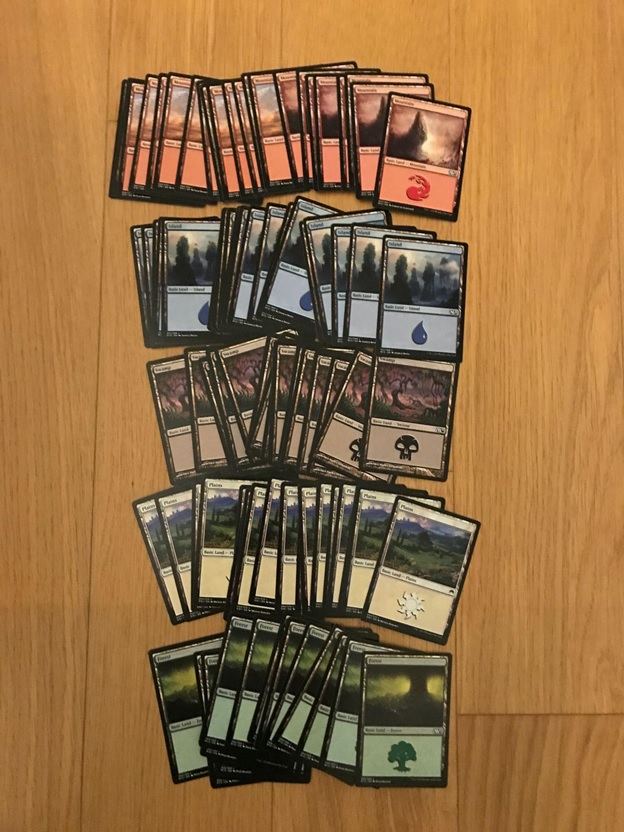
When you set aside those 100 basic lands, you are spending mental energy one-time... That will save your all too human brain for every draft you do from now until the end of time. Moreover, you are doing it with a rerun of How I Met Your Mother in the background, rather than adding to the mental fatigue of a tournament day. I have twenty of each in my bag, even though I will not generally need more than ten of any particular basic most nights. The cost of 20 over 10 one-time is minimal; versus the literally infinite amount of brainpower and frustration savings you get long-term. The cost-benefit simply can't be exaggerated.
Next Level Basics
Beyond whatever effectively limitless supply of basics I (and most of us) have, I own twenty of each basic in Amonkhet full-art:

That's a lie: I own 40+ Mountains for obvious reasons.
I just wanted to own nice basics to play in my Constructed decks. Beyond stuff like the mismatched Mountains troll, I used to spend a lot of time picking cool art for my decks. While I do think you get some cool factor benefit from alternate art or hard-to-find variants... The cards don't themselves do anything different; almost by definition they don't change your win expectation either way.
The argument can be made that with Innistrad: Midnight Hunt, this is no longer the case. Consider...
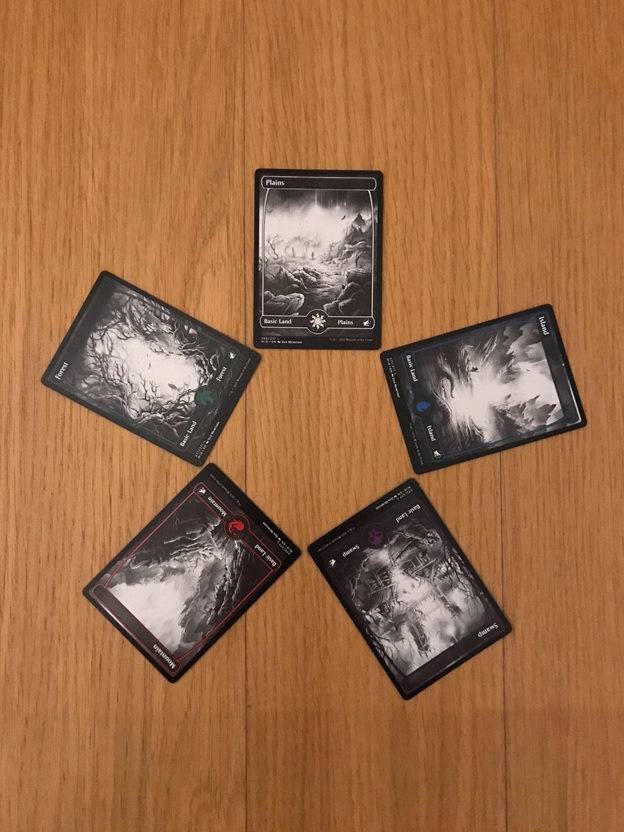
With the exception of one pip and some trim on only three-and-a-half of them, these lands are lighted similarly, and mostly black and white. Here is the same photograph, but in black-and-white.
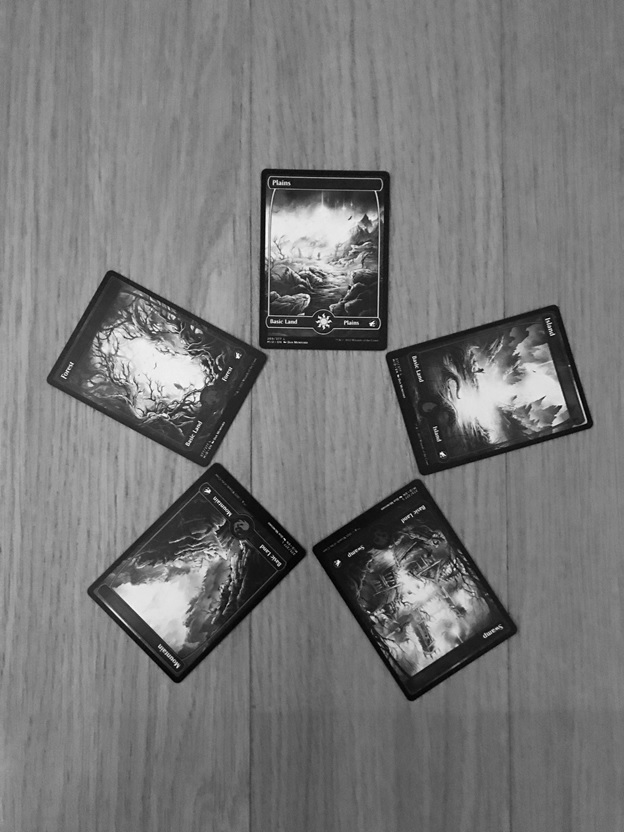
Most of the time we know what basic we are facing at a glance. Less so with Midnight Hunt's, no? Of course, the notable exception is Wald:
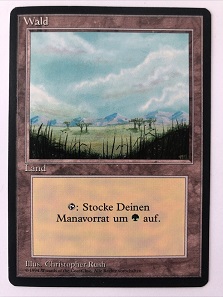
I lost a game to Wald in a Grand Prix back in 1999; and at $40 to $50 per, I have a hard time recommending anyone try to angle shoot with one (or twenty). In fact, I want to stress that I would never advocate explicitly trying to deceive your opponent with no other purpose. But is playing Midnight Hunt basics deceptive on its face?
I'm not sure you can make that argument. And in fact, these are THE format-specific in-print basic lands right now! That said, the potential edge you might get from playing them is undeniable and is worth talking about; at least under two conditions:
- You play a multicolored deck. If you just play all Midnight Hunt Mountains in your Red Deck... You look cool. Cool. These are indeed some of the coolest lands that have ever been printed from an aesthetic perspective. But if your opponent knows every Midnight Hunt basic is a Mountain, they can quickly shift into an accurate mental shortcut and you gain no edge.
- You yourself know which is which. Back in the 1990s, Adrian Sullivan used to lay his battlefield out in a kind of unique way. It made sense to him, and there was certainly nothing against it in the rules... But it was different from how most other players did, and could unnerve some. Even as one of Adrian's primary play-test partners I never mastered the layout; and believe me, I tried. The Corrupter would make the very reasonable statement that he could lay his side of the table out however he liked and would you please take your hands off of his cards. His layout was very effective, in part because Adrian practiced playing this way, so it was second nature to him. That is, some of his opponents had to exert additional mental energy against Adrian's unique battlefield; but he himself could play either style interchangeably. One time a frisky Grand Prix Champion tried to "out Adrian" Adrian heads up and just confounded himself. So probably after accidentally missing an attack or throwing away a free card he re-ordered his whole battlefield to the normal way. In the middle of a match. Take his blunder as a lesson: If you yourself aren't going to know which one is a Forest and which one a Swamp any more than your opponent would, I'd recommend against switching to Midnight Hunt lands, even if you do think they're pretty.
Ultimately, you can win more by adding complexity to your game... Provided that it is one-sided. If you anticipate being even 1% confused by your own cards, I'd suggest you spend your practice time mastering literally anything else.
One more time before we move on: In addition to being the actual in-print basic lands at the time of this writing, I really do think the Midnight Hunt lands are some of the coolest looking all-time. Given that earnest statement - that you probably agree with in the abstract - can anyone fault anyone for wanting to play them?
Alternates and Foreign Cards
In the beginning everyone brewed their own decks.
Over time, as information became more free, the concept of playing "net decks" (at least in tournaments) increased in popularity. Fast forward a couple of decades, and in the Arena era, most of our starting sixties are essentially identical.
In our current world, one of the relatively narrow ways we can flex a little ownership over our decks is to customize the art. Like when I won the Utah RPTQ back in 2015, I remember smiling when my friend (and PT Top 8 competitor Aaron Muranaka) said "somebody won a lot of FNM" at all my alternate art. To wit, these are the Dissolves I played:

They're cool, right? Nominally you had to do something to get them. Would you fault anyone for playing these? Especially if they were the only ones they owned? They were, and remain, the only copies of Dissolve I own. That said, it is undeniable that they don't trigger immediate mental familiarity for the opponent as quickly as would the boring old non-foil Wesley Burt art.
For most of us, foreign cards - especially Asian ones - roar with a similar cool factor. I like all different kinds of foreign prints aesthetically, but really gravitate to the thick lines and geometry of Korean ones. If you've oohed and ahhed at the villain design on Squid Game, you're probably the same kind of geek I am. Prior to acquiring my full-art Amonkhet Mountains, these were my go-tos:
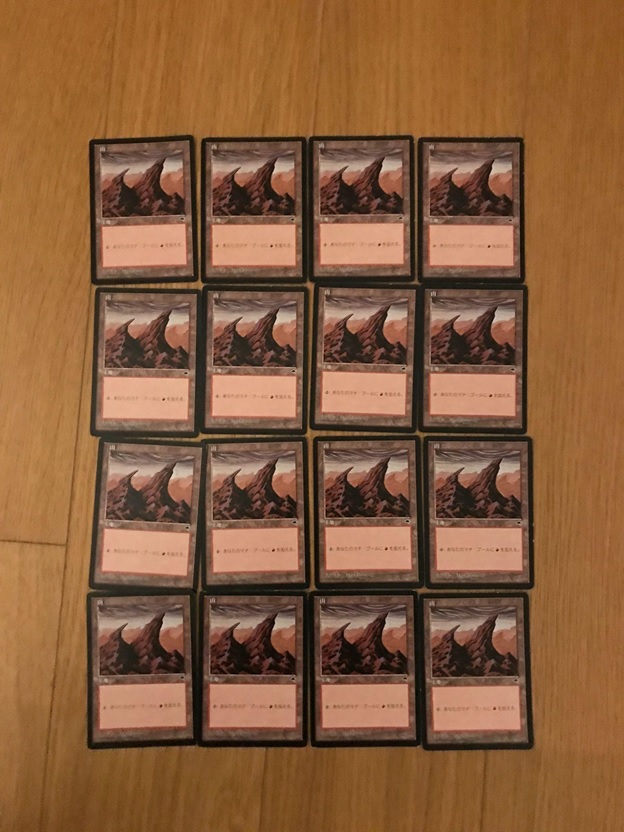
I played these Mountains for two reasons:
- They are from Tempest, the time of Jackal Pup and Mogg Fanatic (and Red friends Wasteland and Cursed Scroll). Part of me felt like I was channeling the apex of Red success in Standard every time I put one of these Mountain in a deck. I felt connected to my old friend and drinking buddy Dave Price and his Pro Tour win.
- Because they're foreign... They're cool! Maybe all our Red Deck Wins are 58/60 the same, but at least the eight or twelve Mountains in my deck are a little customized... You grok?
In the aforementioned Utah RPTQ, I won a Top 8 game at least in part because my opponent tried to counter Dragonlord Dromoka.
My Dragonlord Dromoka was in English. The opponent just made an error partly because the day was long and partly because he wasn't intimately familiar with the card. He tried to take it back. I nicely told him that his play was legal: But like a Mana Leak into three open lands, his Silumgar's Scorn just didn't do anything.
More on this in a second.
Aside: Find the Windmate Roc
At Pro Tour Milwaukee, one of the highest win expectation Standard decks - even if it didn't make Top 8 - was a Bant Midrange deck designed by Sam Black. This deck had cards like Wingmate Roc and Retreat to Emeria. These are good cards; and we would all tend to agree that they are good cards on the order of the ones in more typical deck lists... They were just less commonly played cards than Top 8 Staples like Monastery Swiftspear and Siege Rhino.
Sam's idea was that there are cards that are just as good; but opponents practice against less (or in the case of a Planar Outburst or Quarantine Field, maybe not at all). They might give you free opens, if not misplay against what's nakedly staring at them across the board.
Just like my Utah opponent did when he tried to counter Dragonlord Dromoka.
Can we agree any edge garnered from playing roguish, different, cards is not only fair play, but laudable?
Get the Edge: Hit the Overlap
So, what happens if you just play a foreign Dragonlord Dromoka?
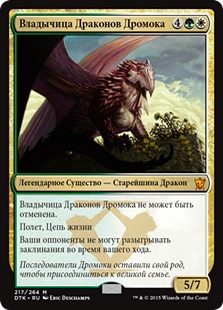
To be clear: The Russian Dragonlord Dromoka was a literal featured promo card.
Foreign Mountain: Customization is not only cool in the abstract, but it gives you ownership of a deck that you otherwise are merely piloting. Thumbs up.
Winning with weird cards because the opponent is less familiar with them (or alternately because you are more creative): Exactly what we want to see in the world. Thumbs way up.
Both: Some players get a little queasy when we do two, different, praiseworthy things at the same time. Again, the potential edge you might get? Not nearly so controversial. A simple way to think about this is that when you play unusual cards, opponents have to think some small percentage harder; consume more willpower. When you do it in another language? That percentage goes up. Over the course of many rounds of a paper tournament? Every round; and even more.
Always Play Fact or Fiction
To the extent that we would "ever" say "always" of course.
At the top of this article, I talked about playing a Premodern tournament next spring. I'll leave you with one of the top performing Azorius Control decks from a European Premodern Championship:
As you can see it played three copies of Fact or Fiction. Fact or Fiction has been a Staple in every format it's ever been legal, even graduating to a four-of in the Top 8 of the Vintage Championships one year. Besides being a guaranteed three cards almost no matter what, Fact or Fiction does something special: It forces - absolutely forces - the opponent to consume willpower in the middle of a game.
Some FoFs are simple. Four lands and one spell often result in a four-one split, and it's up to you to pick which one is better for your hand. Playing your FoF with a threat on the stack can be mentally excruciating; the opponent doesn't necessarily know if you have permission in hand already, so has to weigh that possibility against pile-making should a Counterspell turn up in the top five. Five-spell FoFs have broken more than one mage's spirit.
So, we're looking to play paper Magic again?
Probably a long day where this card is legal?
I love a Jackal Pup more than almost anyone you've ever met; but right now? No Premodern games under my belt yet? If you asked me how many copies of Fact or Fiction I'd be registering next spring? There is only one answer.
And it ain't three.
LOVE
MIKE

























